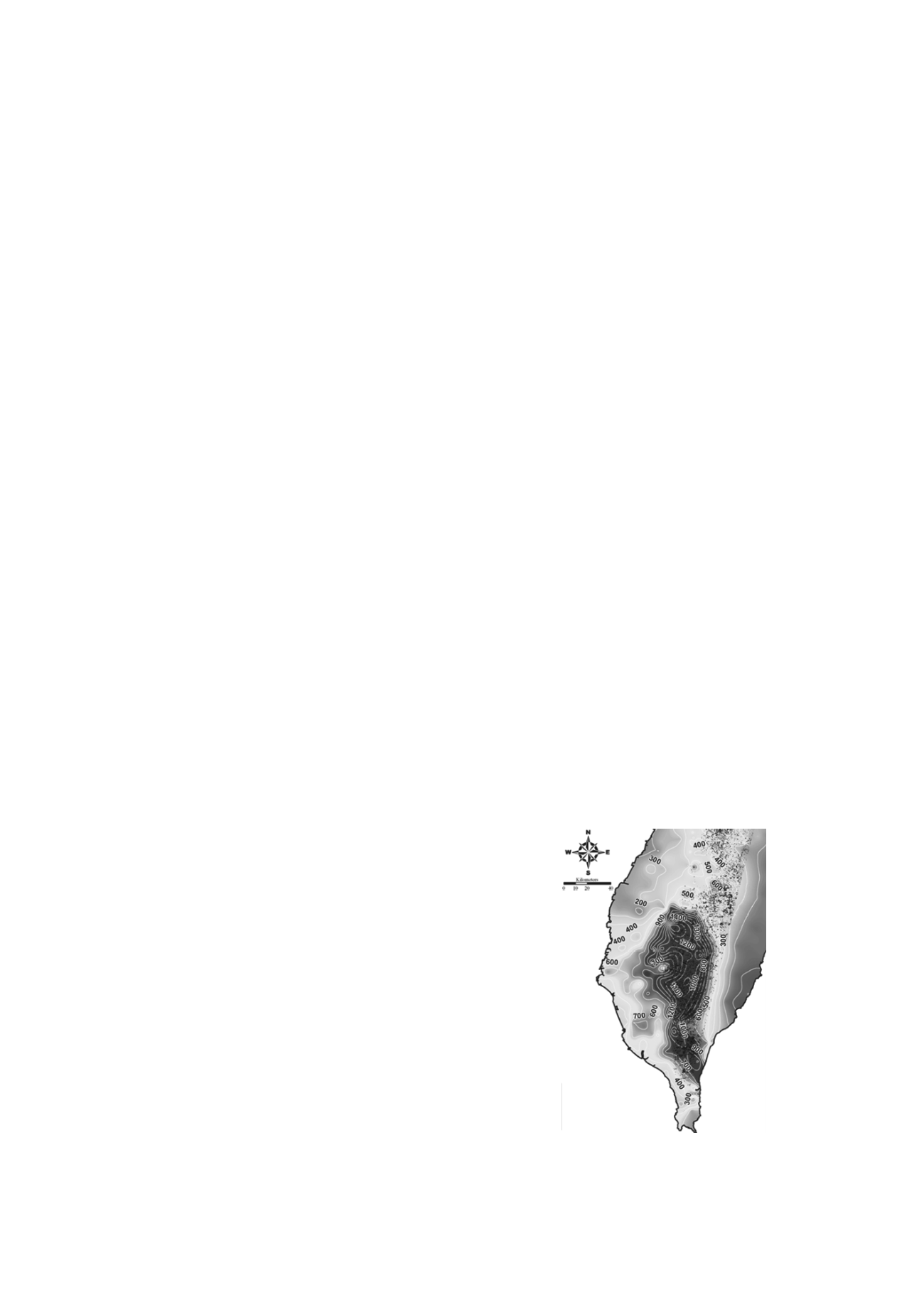
515
Proceedings of the 18
th
International Conference on Soil Mechanics and Geotechnical Engineering, Paris 2013
1
Survey results of damaged areas in flood disaster of typhoon Morakot
and suggestions for restoration projects
Résultats des investigations sur les zones ravagées et inondées par le typhon Morakot,
propositions de projets de restauration
Chou J.C., Huang C.R.
Sinotech Engineering Consultants, Taipei, Taiwan
Shou K.J.
National Chung Hsing University, Taichung, Taiwan
ABSTRACT: Typhoon Morakot attacked Taiwan on August 8th, 2009 and caused heavy rainfall in Taiwan. The precipitation from
August 5th to 10th, 2009 in the survey station of Ali Mountain was about 3049.5mm and the precipitation of 24-hour and 48-hour
period in the south of Taiwan was close to the maximum observed precipitation in the world. This heavy rainfall caused many natural
disasters including landslides, floods and debris flows. These natural disasters severely damaged the middle, south and east of Taiwan
and cost huge property and life losses. Sinotech Engineering Consultants conducted a comprehensive survey after the flood disaster of
Typhoon Morakot (1) to collect information of damaged areas, (2) to analyze the causes and mechanisms of failures and (3) to draft
strategies and suggestions for restoration projects and future projects. Survey areas included the drainage basins of Chenyulan Creek,
Laonong River, Cishan River and Ailiao River, the watershed of Nahua reservoir and Taitung area. Depending on different geological
environments, the survey team concluded ten mechanisms causing failures. This article presents survey observations, discussions of
failures in flood disaster and provides strategies and suggestions for restoration projects and future projects.
RÉSUMÉ : Le typhoon Morakot a atteint Taiwan le 8 août 2009 accompagné de fortes pluies. Les précipitations du 5 août au 10 août
2009, mesurées à la station d’Ali Mountain, ont été de 3 049,5 mm, entraînant dans le sud de Taiwan des niveaux de précipitation en
24 heures et 48 heures proches des maximums de précipitations connues dans le monde. Les fortes pluies ont causé de nombreux
cataclysmes naturels tels que glissements de terrains, inondations et charriage de débris, qui ont ravagé le Centre, le Sud et l’Est de
Taiwan entraînant des pertes en vie humaines. Par la suite, le bureau d’ingénierie Sinotech a réalisé des études détaillées afin de
dresser un bilan exhaustif des dégâts des inondations causées par le typhon Morakot : (1) recensement et investigation des zones
ravagées ; (2) analyse des causes et des mécanismes des désordres, (3) ébauches de stratégies et solutions pour les travaux de
restaurations et les projets futurs. Les zones d’investigations comprenaient les bassins versants de Chenyulan Creek, Laonong River,
Cishan River et Ailiao River, le bassin hydrographique du réservoir Nahua et de la zone de Taitung. Suivant les différents
environnements géologiques identifiés, les investigations ont conclu à dix mécanismes à l’origine des désordres. Cet article présente
les résultats des investigations sur sites, l’établissement des mécanismes des désordres liés aux inondations qui en suivirent ainsi que
les solutions de restaurations et les projets correspondants.
KEYWORDS: Typhoon Morakot, Landslides, Debris Flows
1 INTRODUCTION
Typhoon Morakot attacked Taiwan on August 8th, 2009
causing heavy rainfall in Taiwan. The precipitation from August
5th to 10th, 2009 in the survey station of Ali Mountain was
about 3049.5mm and the precipitation of 24-hour and 48-hour
period in the south of Taiwan was close to the maximum
observed precipitation in the world. Figure 1 shows the
maximum accumulated precipitation in 24 hours in the south of
Taiwan. This heavy rainfall caused floods, many natural
disasters and severely damaged mountain areas of the middle,
south and east of Taiwan. All these floods and disasters are
called “88” Flood. “88” Flood caused 643 deaths, 60 missing,
2,555 injured and 16.5 billion NT dollars economy lost which
makes “88” Flood the worst natural disaster since Chi-Chi
Earthquake happened on September 21, 1999. The most severe
disaster is the disaster in Xiaolin village. The village was
destroyed by a catastrophic debris flow during Typhoon
Morakot. Over 500 residents were buried alive and 350 houses
were damaged.
Right after “88” Flood, Sinotech Engineering Consultants
conducted a comprehensive survey on slopelands, roads,
bridges and hydraulic facilities in the drainage basins of
Chenyulan Creek, Laonong River, Cishan River and Ailiao
River, the watershed of Nahua reservoir and Taitung area (See
Figure 2). Purposes of this survey are (1) to collect information
of damaged areas, (2) to analyze the causes and mechanisms of
failures and (3) to draft strategies and suggestions to restoration
projects and future projects.
—
Rainfall Isoline
Figure 1. Maximum accumulated precipitation in 24 hours in the south
of Taiwan (Precipitation in mm).


